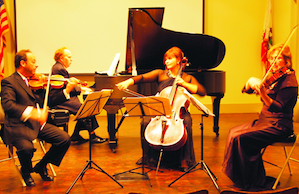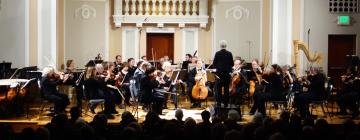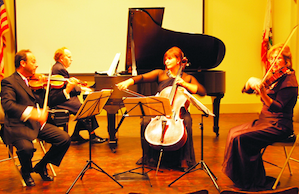
The Gold Coast Chamber Players kicked off a promising new season last weekend. Its series of five concerts arranged around themes such as “Concertante,” “American Frontiers,” and “Transcendent” will offer chamber music as diverse as Haydn’s Sinfonia Concertante, Copland’s Appalachian Spring (in the original version for 13 musicians), and Messiaen’s Quartet for the End of Time.
The season opener was themed “Quintett” (the German spelling) and featured Romantic cello quintets by Alexander Glazunov (1865–1936) and Franz Schubert (1797–1828). For this performance, the Gold Coast Chamber Players (GCCP) had ventured away from their home, the Lafayette Library Community Hall, where the concert was repeated on Saturday.
The Friday concert was held at the Orinda Library Auditorium, a space that, apart from an annoyingly noisy air conditioning system, is almost perfect for chamber music. It is a surprisingly good-sounding little hall with nice proportions that offers a pleasant balance of distance and intimacy between audience and performers.
GCCP’s artistic director, Pamela Freund-Striplen, recruits many of her musicians from the Bay Area. The “Quintett” lineup included cellist Amos Yang, who is San Francisco Symphony’s assistant principal cellist, violinist Rebecca Jackson, and cellist Angela Lee. The special guest star was violinist Juliana Athayde, who grew up in Orinda and is currently concertmaster of the Rochester Philharmonic Orchestra. Freund-Striplen herself completed the quintet on viola.
The cello quintet is a variation on the standard string quartet combination (two violins, viola, cello), supplemented with a second cello. It is less common than a string quintet with an extra viola (which Mozart favored), and few composers have written for this specific kind of string ensemble. Wikipedia lists only about two dozen of them; most produced a single cello quintet. One notable exception is Luigi Boccherini (1743–1805), who composed more than 100 of them.
The Schubert quintet was in every respect the most profound musical experience of the evening. Too bad it had to end.
Schubert’s String Quintet in C Major, D. 956, the main course of Friday night’s concert, is by every standard a chamber music masterpiece, and it is almost unfair to program it next to Glazunov’s String Quintet in A Major, Op. 39. Other than the instrumentation and a four-movement structure, these pieces have little in common.
Glazunov was an extremely talented composer whose work no doubt deserves to be more well-known than it currently is. A transitional figure who gave direction to the development of Russian music, he forms a direct link between Nikolai Rimsky-Korsakov (1844–1908), who was his teacher, and Dmitri Shostakovich (1906–1975), who studied at the St. Petersburg Conservatory when Glazunov was director.
His cello quintet opens with a radiant, optimistic melody for the viola, but Glazunov gives every instrument equal weight within the ensemble. Often more Viennese than Russian in spirit, but showing shades as Slavonic as Dvořák, the music embodies every stereotype of “romantic music,” though it never really transports you the way the opening notes of Schubert’s quintet do — nor does it grab you by the throat like the simple but oh-so-moving two-note theme at the beginning of the Adagio. Glazunov’s music has been described as academic and “lacking originality,” and I am sorry to say that hearing it alongside Schubert makes you realize how someone could come to that conclusion.
In their playing and stage presence as an ensemble, the musicians of the Gold Coast Chamber Players reflected this difference in intensity. A bit detached in the Glazunov piece, they were much more engaged — and engaging — in the Schubert quintet, which was in every respect the most profound musical experience of the evening. Too bad it had to end.

